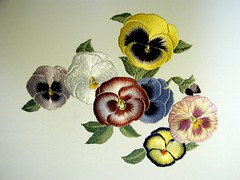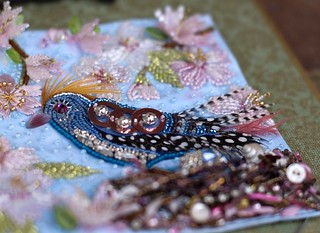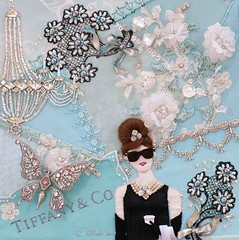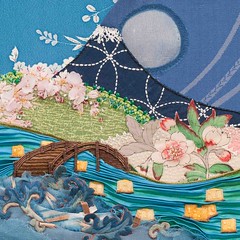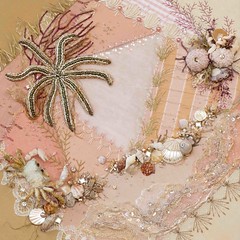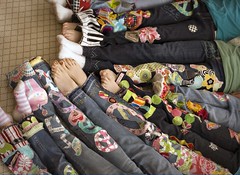There is no "Becoming a Queen" without a Coronation --
A crowning of the royal sovereign...

And so, when it came time to decide on a gown design for Your Majesty, I looked to the coronation gowns of queens in history. And it was the worldwide inclusiveness of the embroidery on the British gowns that struck me.
Historically, the robe played the primary role in the British Coronation ceremony. Typically, the dress was kept fairly simple since the robe had a tendency to obsure everything underneath.
But with the advent of Queen Alexandra, the dress rather than the robe began to take on increased significance.
Queen Alexandra paid close attention to her gown for the coronation of Edward VII (pictured left)...It was made from gold tissue and white net, embroidered with gold spangles and gold/silver floral sprays. At the time, Queen Alexandra chose to include Indian flora, the National emblems of rose and thistle, saxon crowns, fleur-de-lis, and the Royal crown as decorative, embroidered motifs.


Queen Mary's dress extended the trend started by Queen Alexandra for the coronation of George V (pictured middle). Her gown included elaborate embroidery of the National Emblems. And lastly, Queen Elizabeth (pictured right) in 1937 further expanded on this theme by including not only the National Emblems but the Imperial emblems of the British empire as well.
So when it was time for the Coronation of Queen Elizabeth II in 1953, the historical precedent had been set. And, it was this dress, the Coronation gown of Queen Elizabeth II, designed by Royal couturier Norman Hartnell, that become the ultimate inspiration for my gown...
The embroidery was designed and carried out by the Royal School of Needlework, taking 3,500 hours between March and May of 1953 to complete. The Queen chose not to wear a surcoat which lent even further significance to the gown itself.

The design was executed in seed pearls, crystals, colored silks and gold and silver thread. The embroidery was laid out to take into careful account the changes in the composition of the Empire since 1937 and the evolution of the Commonwealth.

The National emblems of the Tudor rose (England), the leek (Wales), the shamrock (Ireland) and thistle (Scotland), as well as all the emblems of the Commonwealth...the maple leaf (Canada), wattle flower (Australia), fern (New Zealand), protea (South Africa), lotus (India), and wheat/cotton/jute (Pakistan)...were all included on Queen Elizabeth's gown.
Since Mr. Hartnell had also designed Queen Elizabeth's wedding gown, her mother requested that more color be added to the embroideries so the gown would not appear too bridal with its silver/gold embroideries on ivory satin.
In doing his research for the design, Mr. Hartnell ran into a bit of a struggle regarding the inclusion of the Leek for Wales, preferring to use the floral motif of a daffodil:
Hartnell checked them with the Garter King of Anno and was horrified to discover that the emblem for Wales was not a daffodil, but a dull vegetable, the leek. The Garter flatly refused to allow the use of the daffodil. Hartnell finally 'borrowed' the leek on the cap of the Welsh Guards and his embroideresses interpreted it into an attractive motif using fine silks and diamante. The leek became a source of inspiration and most of the other emblems were interpreted in the same way.
The leek appears at the very middle top of the skirt just below the bodice.

To get final approval for the embroidered emblem designs, Mr. Hartnell presented this sampler to the Queen and her Mom...

(I noticed that the leek and/or daffodil is left out of this piece which makes me suspect that the final decision regarding the humble vegetable had not yet been made at the time that the sampler was completed?)...The only change to the embroidery design was to deepen the green for the Irish shamrock....
After the embroidery of the gown was completed, Mr. Hartnell added an extra shamrock on the left hip for good luck so that Queen Elizabeth's hand might rest upon it all day long throughout the ceremonies...
And so my challenge was to interpret these items in miniature on my little 8" gown...
Here is the rose, the maple leaf, the lotus and the wattle flower (gold sequins)...


The protea flower...

And the leek!! (down in the lower right corner)...

And last but not least, tucked just under the ribbon garland, on the left hip...an extra shamrock...for good luck...

Because my gown had taken on such a British character, I decided to marry the British Union Jack flag with the American flag for my background, printing the words of the Norwegian proverb on silk...
In every woman, there is a Queen. Speak to the Queen and the Queen will answer.
Reminding us all of the majesty that exists within each one of us.
Your Majesty.
THE END
Sources:













































